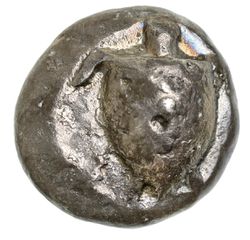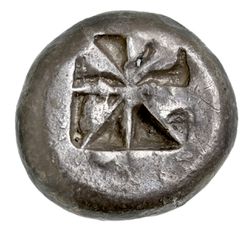Greek Silver & Bronze Coins
Lot 2867 SESSION 16 (9.30AM FRIDAY 21ST MARCH)) Greek Silver & Bronze Coins
Estimate $3,000
Bid at live.noble.com.au
SOLD $3,000
ATTICA, Aegina (Aigina), (525/520-510 B.C.), silver stater, (12.24 g), obv. sea turtle with row of dots down dorsal spine, countermarked with trace of symbol, rev. 'Rough incuse developed early proto Union Jack pattern' some with broken segments, (cf.S.1849, Asyut Group IIa, a late transitional issue from I to II, ANSMN 33, No.56 (This Coin), Meadows Group IIa, SNG Fitz 3245 (Pl.LX), SNG Delepierre 1502, Holloway Group period 2, (Thin Collar Turtle, Union Jack pattern reverse), Brown Class III (dates 550-500 B.C.), cf. Asyut 424 [P.69 Pl.XIX for obverse die] Selinus Hoard No 56 [This Coin], HGC 6, 428). Toned, good very fine/extremely fine and very rare.
Ex Sotheby Auction Sale, New York December 9, 1993 "The Athena Fund Sale" (Lot 392 part); coming from the Selinus Hoard ANSMN 33, No.56.^The obverse and probably the reverse from the same dies as Matala Hoard ANS 17, (p.2) Nos.5-6 and the same obverse die in Taranto Hoard = McClean 6009. The Asyut hoard suggests the chronology to be c.500 B.C. Much has been written on this early coinage since Samuel Millbank published 'The Coinage of Aegina' in 1924. Since then various numismatic scholars endeavoured to establish the order of issue and the chronolgy of this series, usually by employing data from a relevant hoard. They include W.L. Brown 'Pheidons Alleged Aeginetan Coinage' (NC 1950, pp.177-204); R. Ross Holloway, 'An Archaic Hoard From Crete and the Early Aeginetan Coinage' in ANS Museum Notes 17 (1971, pp.1-21, (based on his doctoral dissertation [The Elder Turtles of Aegina, 1960, Princeton University]); Price and Waggoner, 'Archaic Greek Silver Coinage, The 'Asyut' Hoard', pp.69-76; Carmen Arnold-Biucchi et al., 'A Greek Archaic Silver Hoard from Selinus' (ANS Museum Notes 33 pp.14-22). They place this proto-tortoise type between the earliest and later strikings. That they belong to Group 2 which is assured by the Union Jack reverses. The chronology is still under review and new hoards when published will all contribute to finally resolving the matter.^Aegina's coinage was very important in the Greek world. According to Ephorus, historian from Cyme, it was the first city to mint silver coinage to facilitate the mercantile practices of its inhabitants, who engaged in trade to make up for the poverty of the agricultural soil. Aegina's coinage is certainly among the oldest and played a leading role among the Aegean islands, which adopted its weight for their own coinage. Very widespread is the diffusion of early Staters from the mid-6th century BC, with the sea turtle type remaining a constant throughout production. The only variation is the change to land tortoise that occurred after the defeat suffered against the Athenians in 431, at the beginning of the Peloponnesian War. (Courtesy of CNG)
Estimate / sale price does not include buyer's premium (currently 22% including GST) which is added to hammer price. All bids are executed on the understanding that the Terms & Conditions of sale have been read and accepted. For information on grading and estimates please refer to the Buying at Auction advice.
Quick find
View a lot by number and sale.
Adjacent lots
Lot 2865
BOIOTIA, Thebes, (363-338 B.C.), magistrate Epaminondas, issued 364-362 B.C., silver stater, (11.86 g), obv. Boiotian ...
Estimate $2,000
Lot 2866
BOEOTIA, Federal Coinage, (c.220s B.C.), AE 17 (3.67 g). obv. head of Demeter or Kore ...
Estimate $100
Lot 2867 This lot
ATTICA, Aegina (Aigina), (525/520-510 B.C.), silver stater, (12.24 g), obv. sea turtle with row of ...
Estimate $3,000
Lot 2868
ATTICA, Islands off, Aegina, (Aigina), (510-490 B.C.), silver stater, (12.03 g), obv. smoothed shell sea ...
Estimate $400
Lot 2869
ATTICA, Athens, (393-300 B.C., but c.360-300 B.C.), silver tetradrachm, (17.05 g), obv. head of Athena ...
Estimate $500

